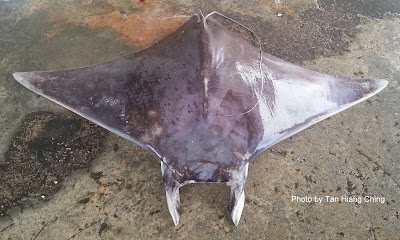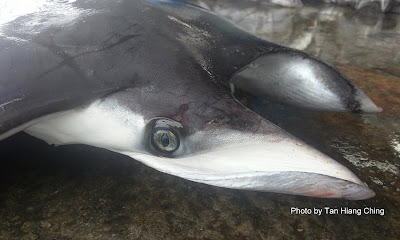Myliobatidae (Devil Rays)
Manta rays and devil rays are the common names for the members of the Mobulinae, a subfamily for the Myliobatidae (Eagle and Manta Rays) family. Similar to stingrays, eagle rays have broad, wing-like pectoral disc and have a very long tail. They are distinguished by their anteriorly extending rostral or cephalic fins that resemble a pair of horn.
Members of the Mobulinae are found in the temperate and tropical continental and insular seas worldwide. There are 2 genera and 11 species worldwide. They can be found from the seashore to a depth of at least 500 m, occurring on both soft and hard bottom around coral and rocky reefs, near kelp beds, and in estuaries, lagoons, and enclosed and open bay. These rays are strong and active swimmers, found near or on the bottom but often swimming well above it. Even the largest Devil Rays (Manta) are highly mobile and readily leap completely out of the water. All species are live-bearing. They have relatively weak jaws and small teeth that are not used for processing prey. Instead, they feed by filtering out planktonic animals and fishes that pass through their large mouths and are caught on the filter plates on their internal gill openings. The rostral fins aid in directing prey into the mouth.
Members of the Mobulinae are found in the temperate and tropical continental and insular seas worldwide. There are 2 genera and 11 species worldwide. They can be found from the seashore to a depth of at least 500 m, occurring on both soft and hard bottom around coral and rocky reefs, near kelp beds, and in estuaries, lagoons, and enclosed and open bay. These rays are strong and active swimmers, found near or on the bottom but often swimming well above it. Even the largest Devil Rays (Manta) are highly mobile and readily leap completely out of the water. All species are live-bearing. They have relatively weak jaws and small teeth that are not used for processing prey. Instead, they feed by filtering out planktonic animals and fishes that pass through their large mouths and are caught on the filter plates on their internal gill openings. The rostral fins aid in directing prey into the mouth.
Scientific Name: Mobula kuhlii (Müller & Henle, 1841)
English Name: Shortfin Devil Ray, Lesser Devilray
French Name: Petit diable
Chinese Name | 鱼类中文名: 魟鱼 (Hōng yú), 魔鬼鱼 (Móguǐ yú)
Malay Name | Nama Melayu Malaysia: Ikan Pari, Pari Paus Tanpa Duri, Pari Kelawar, Pari Kalok
Thai Name | ชื่อสามัญภาษาไทย: ปลากระเบนปีศาจครีบสั้น (Plāk ra ben pīṣ̄āc khrīb s̄ận)
Main Identification Features: Dorsal fin with a white spot at apex. Cephalic-fin relatively short, less than 16% of disc width. Pectoral fins with slightly curved tips. Front margin of pectoral fins not undulated, slightly convex. Dark brown above, white below.
Size: Maximum 120 cm disc width. Born at about 31 cm disc width. Males mature at about 115 cm disc width.
Habitat and Ecology: Coastal and oceanic waters. Usually found in schools. Capable of leaping out of the water. Feeds on planktonic crustaceans and possibly small fishes and cephalopods.





English Name: Shortfin Devil Ray, Lesser Devilray
French Name: Petit diable
Chinese Name | 鱼类中文名: 魟鱼 (Hōng yú), 魔鬼鱼 (Móguǐ yú)
Malay Name | Nama Melayu Malaysia: Ikan Pari, Pari Paus Tanpa Duri, Pari Kelawar, Pari Kalok
Thai Name | ชื่อสามัญภาษาไทย: ปลากระเบนปีศาจครีบสั้น (Plāk ra ben pīṣ̄āc khrīb s̄ận)
Main Identification Features: Dorsal fin with a white spot at apex. Cephalic-fin relatively short, less than 16% of disc width. Pectoral fins with slightly curved tips. Front margin of pectoral fins not undulated, slightly convex. Dark brown above, white below.
Size: Maximum 120 cm disc width. Born at about 31 cm disc width. Males mature at about 115 cm disc width.
Habitat and Ecology: Coastal and oceanic waters. Usually found in schools. Capable of leaping out of the water. Feeds on planktonic crustaceans and possibly small fishes and cephalopods.




